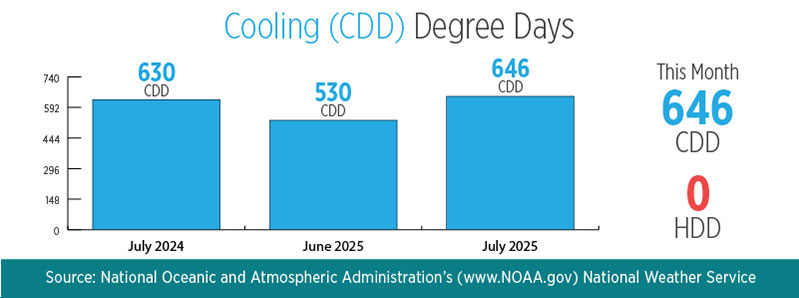What to expect on your August bill

Summer showers were almost a daily occurrence in the first half of July, but by mid-month, a heat dome settled in, keeping the rain away and setting the stage for the dog days of summer to take over. By the end of the month, North Texas recorded its first triple-digit temperature of 2025, including a high of 104 on July 31.
Overall, July was warmer than June, so Members used more air conditioning, resulting in higher energy usage.
Good news for August: CoServ Members will pay less per kilowatt-hour, and eligible Members will also notice a bill credit on their August bill in the form of a Capital Credit retirement.
The chart below explains how utilities use Cooling Degree Days (CDD) and Heating Degree Days (HDD) to link average daily temperatures directly to energy use.
| June | July | Difference | |
|---|---|---|---|
| Average temperature | 82.4 | 85.5 | 3.1 degrees warmer |
| Heating Degree Days | 0 | 0 | 0 HDD |
| Cooling Degree Days | 530 | 646 | 116 more CDD |
| Utilities and the federal government measure the impact of weather on energy usage by calculating Cooling Degree Days (CDD) and Heating Degree Days (HDD). To calculate the CDD, take the average temperature for a day and subtract it from 65. The higher the number, the more air conditioning will be needed to keep your home comfortable. Click here for more information on calculating CDD. | |||
July 2024 versus July 2025
July 2025 had three 100-degree days compared to six in the same month last year. So, how could the Cooling Degree Days be higher for July 2025?
The CDD is calculated using the average daily temperature, which was 85.5 for July 2025. The average daily temperature for July 2024 was 85.1, a difference of 0.4 degrees. So, while there were fewer 100-degree days in July 2025, the overall average daily temperature was higher in 2025, resulting in a higher CDD and slightly more energy usage.
For example, high temperatures reached 95 degrees or higher on 18 days last month, and even the nights were warm with lows of 75 or higher on 22 of the 31 days. Compared to July 2024 where 17 days were 95 degrees or higher and the nights had lows of 75 or higher on 13 of the 31 days.
Despite the daily storms, North Texas only received 1.52 inches of rain in July 2025, about half an inch below normal and a whole inch less than the region received in 2024. Many of the storms only left a trace of precipitation.
Rates
While energy usage will likely be up for July, CoServ Members will pay less per kilowatt-hour.
CoServ adjusted the Power Cost Recovery Factor (PCRF) by two-tenths of a penny to -$0.01, meaning it subtracts a whole penny off the base rate. As a result, Members should pay $2 less for every 1,000 kWh on their August bill compared to last month. This is also the 14th straight month that the PCRF has been a negative number.
The Standard residential rate for August will be 12.23 cents per kWh.
We make every effort to keep electricity rates affordable while delivering safe and reliable power to Members. When we save money by making strategic wholesale electricity purchases, we pass that on to Members, as we did this month.
Also, CoServ Members who joined the co-op prior to January 2025 will notice a bill credit on their August bill. This is a Capital Credit retirement, approved by the CoServ Electric Board of Directors, a major component of the CoServ Advantage.
Click here to learn more about how your CoServ electric rate is calculated.





